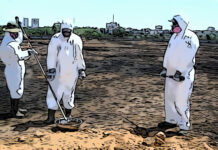PFAS, furans, glycoalkaloids, Alternaria are four categories of food contaminants that the European Commission ‘recommends’ to monitor rather than ban, although they are widespread and dangerous to public health (1,2,3,4).
Food safety, from words to deeds
Food safety is theoretically guaranteed by a number of EU regulations such as General Food Law (EC reg. 178/02), Hygiene Package, (EC reg. 852,853/04 et seq.), Official Controls Regulation (EU reg. 2017/625).
However, the European Commission stubbornly fails to take the necessary safeguard measures in the most serious cases, thus giving way once again before the interests of industry. As has already been reported in the cases of acrylamide, bisphenol A (BPA), mycotoxins, 3-MCPD and glycidyl esters.
In the cases to follow, the Brussels executive is therefore limited to requiring food industries to collect and transmit to EFSA analytical data on the concentrations of toxic substances in various categories of food.
1) Furans
Furans and alkyl furans are process contaminants that are formed in some foods due to the heat treatments they undergo. Among the most representative are the methylfurans, 2-methylfuran, 3-methylfuran, and 2,5-dimethylfuran primarily.
1.1) Furans, EFSA opinion.
EFSA (2017) indicated that:
- levels of exposure to furans and alkyl furans are of concern,
- methylfurans can add up and increase exposure significantly.
Coffee
, jarred baby food, ready-to-eat soups, potato chips, fruit juices, breakfast cereals, cookies, crackers, and crusty bread are the most contaminated foods. Waiting for more data on methylfurans. (5)
1.2) EU Recommendation 2022/495
Furan, 2-methylfuran and 3-methylfuran should be monitored in foods at risk, taking care to employ representative samples. To this end, reference is made to the sampling procedures in Reg. EC 333/2007, Annex, Part B. (6) Other furans, ‘if possible,’ should also be monitored.
Analysis of major furans in coffee and jarred baby food should meet the criteria given in the recommendation. Other foods should employ a method otherwise suitable to meet these criteria, with a limit of quantification (LoQ) < 5 μg/kg and control procedures to ensure the reliability of results.
2) Alternaria toxins
The genus Alternaria includes ubiquitous molds that can grow on both food and other types of environments. Such molds produce toxins that are very dangerous to health (cyto- and genotoxicity, pro-inflammation, endocrine disruption, microbiota dysbiosis). And yet, they are still without legal limits. (7)
2.1) Alternaria, EFSA evaluation.
EFSA’s latest assessment (2011) already shows that exposure to the main toxins (alternariol, alternariol monomethyl ether, tenuazonic acid) exceeds the toxicological alert threshold. Therefore, the Authority recommended collecting data on several foods most at risk and implementing more sensitive methods. (8)
Preventing and reducing contamination of food by Alternaria genus toxins is possible, but good agricultural and manufacturing practices, storage conditions, and transportation are necessary. And it is still useful to understand the factors that lead to higher levels of toxins in foods, in order to adopt precise and timely strategies for reduction and prevention.
2.1) EU Recommendation 2022/553
Brussels proposes ‘indicative levels’ – rather than safety levels, when they are exceeded, the factors behind their occurrence and the
The effects of transformation processes.
The main foods to be monitored are processed tomato products, paprika powder, sesame seeds, sunflower seeds and oil, nuts, dried figs, and cereal-based foods for infants and young children.
Sampling procedures should follow reg. EC 401/06, with LOQ not exceeding 2 μg/kg in cereal-based foods intended for infants and young children, 4 μg/kg in other foods. LOQ not exceeding 20 μg/kg, on the other hand, for the determination of tenuazonic acid in all foods. And the analyses should be extended, ‘where possible,’ not only to the three main toxins but also to the other Alternaria genus.
3) Glycoalkaloids from potatoes and derivatives
Glycoalkaloids are secondary metabolites that accumulate in potatoes. In the ‘green stage,’ as far as tubers are concerned, that is, in the aerial parts of the plant. They are toxic and can cause intestinal disorders, vomiting, fever, diarrhea, neurological problems, with possible lethal effects. The different stages of production, sun exposure in the first place, promote their development. And cooking does not reduce its presence or inhibit its toxicity. (9)
3.1) Glycoalkaloids, the EFSA opinion.
The most important toxins are α-solanine and α-caconin, and EFSA (2020) noted how the minimum threshold for observing a harmful effect(Lowest-observed-adverse-effect level, LOAEL) – equal to 1 mg/day of total glycoalkaloids/kg body weight – is often reached and exceeded, with health concerns. (10)
Therefore, the concentration of glycoalkaloids in potato tubers must be reduced through the adoption of good agricultural and manufacturing practices. With particular regard to, among other things, storage and transportation conditions.
3.2) EU Recommendation 2022/561
Member states and food business operators should monitor α-solanine and α-caconin in potatoes and potato products. It is ‘if possible’ also degradation products (β- and γ- solanine, caconin, solanidine aglycone), particularly in processed potato products, with the suggested methods of sampling and analysis (LOQ between 1 and 5 mg/kg maximum).
Attention should be paid to:
- Identify factors leading to levels above the indicative level of 100 mg/kg as the sum of α-solanine and α-caconin, in potatoes and processed potato products,
- Record the variety and size of potatoes, whether they are early potatoes or storage potatoes (i.e., ripe and/or stored for a longer period), the stage of sampling, peeling, and method.
4) PFAS
PFAS-an endless group of perfluoroalkyl substances known as ‘forever chemicals‘-are widely used in every industrial sphere and in consumer products, including food contact materials (MOCAs), as noted.
Planetary environmental contamination by PFAS, now extended to rainwater as well, can impact the food supply chain. It is therefore necessary to control sources of dietary exposure as early as soils, feed, agricultural and drinking water.
4.1) PFAS, EFSA Assessment.
The EFSA (2020) assessment focused on the main molecules, in the broad group of ‘forever chemicals‘. PFOS, PFOA and their salts are present at the highest concentrations in both food and humans exposed to these almost unavoidable contaminants.
The European Food Safety Authority also considered PFNA and PFHxS, based on data collected under Recommendation 2010/161/EU. Noting how the exposure of part of the European population exceeds the tolerable weekly dose. (11)
4.2) PFAS, EU recommendation 2022/1431
Monitoring of major PFASs should be supplemented with that of similar substances but with a different alkyl chain, so-called emerging PFASs, which may be present in food, drinking water and/or human serum.
Foods to be analyzed (in edible parts only) should include fruits, vegetables, starchy roots and tubers, seaweed, cereals, nuts, oilseeds, foods for infants and young children, foods of animal origin, soft drinks, wine and beer.
One must consider both the products of primary agriculture, as well as feed and food made from the same lot, and processing factors. Always specifying the characteristics of processes and products.
4.3) PFAS, sampling and analysis.
Sampling should follow the procedures described in reg. EU 2022/1428 and analyses in accordance with reg. EU 2017/625, Article 34. Analytical methods should have LOQs less than or equal to those given for different PFASs, ‘where possible’.
Causes of contamination should be investigated where indicative levels are exceeded:
(a) 0.010 μg/kg for PFOS, 0.010 μg/kg for PFOA, 0.005 μg/kg for PFNA, and 0.015 μg/kg for PFHxS in fruits, vegetables (except wild mushrooms), and starchy roots and tubers,
(b) 1.5 μg/kg for PFOS, 0.010 μg/kg for PFOA, 0.005 μg/kg for PFNA, and 0.015 μg/kg for PFHxS in wild mushrooms,
(c) 0.020 μg/kg for PFOS, 0.010 μg/kg for PFOA, 0.050 μg/kg for PFNA, and 0.060 μg/kg for PFHxS in milk,
(d) 0.050 μg/kg for PFOS, 0.050 μg/kg for PFOA, 0.050 μg/kg for PFNA, and 0.050 μg/kg for PFHxS in baby food.
5) Data monitoring and sharing
The results of monitoring activities carried out by food business operators and member states should be sent to EFSA by June 30 each year. Based on the standardized sample description (SSD) guidelines for food and feed and other specific information requirements of the Authority. (12)
The number of accredited laboratories with accredited methods for the analysis of contaminants under investigation in food and feed is still quite small. Therefore, the commitment of these laboratories to validate the necessary analytical methods and increase the capacity for contaminant screening at the European level is required.
6) Interim Conclusions
During 2022, the European Commission-in agreement with the member states, in the PAFF(Plants, Animals, Food and Feed) Committee-has set several goals in terms of monitoring contaminants in food supply chains. Considering both a wide variety of food matrices and a range of contaminants that have hitherto been little (or not at all) considered, with a view to collecting further data on their trophic-level distribution.
Chemical safety of food and food contact materials (MOCA)-as most recently found in the swiss study (Biedermann et al., 2022) on the migration of toxic chemicals from glass jar seals onto oily foodstuffs – however, remains one of the most serious unresolved gaps, in the EU as elsewhere.
Dario Dongo and Andrea Adelmo Della Penna
Notes
(1) Commission Recommendation (EU) 2022/495, 25.3.22, on the monitoring of the presence of furan and alkyl furans in food http://data.europa.eu/eli/reco/2022/495/oj
(2) Commission Recommendation (EU) 2022/553, 5.4.22, on monitoring for the presence of Alternaria toxins in food http://data.europa.eu/eli/reco/2022/553/oj
(3) Commission Recommendation (EU) 2022/561, 6.4.22, on monitoring the presence of glycoalkaloids in potatoes and potato products http://data.europa.eu/eli/reco/2022/561/oj
(4) Commission Recommendation (EU) 2022/1431, 24.8.22, on the monitoring of perfluoroalkyl substances in food http://data.europa.eu/eli/reco/2022/1431/oj
(5) EFSA CONTAM Panel (2017). Risks for public health related to the presence of furans and methylfurans in food. https://doi.org/10.2903/j.efsa.2017.5005 EFSA Journal 15(10):5005
(6) Reg. EC 333/07, on methods of sampling and analysis for the official control of levels of lead, cadmium, mercury, inorganic tin, 3-MCPD and benzo(a)pyrene in foodstuffs. Consolidated text as of 19.5.21 http://data.europa.eu/eli/reg/2007/333/2021-05-19
(7) Alchinger et al. (2021). Alternaria toxins-Still emerging? Comprehensive Reviews in Food Science and Food Safety. 20(5):4390-4406 https://doi.org/10.1111/1541-4337.12803
(8) EFSA CONTAM Panel (2011). Scientific Opinion on the risks for animal and public health related to the presence of Alternaria toxins in feed and food. https://doi.org/10.2903/j.efsa.2011.2407 EFSA Journal 9(10):2407
(9) Omayio et al. (2016). A Review of Occurrence of Glycoalkaloids in Potato and Potato Products. Curr. Res. Nutr. Food Sci. 4(3) http://doi.org/10.12944/CRNFSJ.4.3.05
(10) EFSA CONTAM Panel (2020). Risk assessment of glycoalkaloids in feed and food, in particular in potatoes and potato-derived products. https://doi.org/10.2903/j.efsa.2020.6222 EFSA Journal 18(8):e0622
(11) EFSA Contam Panel (2020). Risk to human health related to the presence of perfluoroalkyl substances in food. https://doi.org/10.2903/j.efsa.2020.6223 EFSA Journal 18(9):6223
(12) EFSA (2021). Call for continuous collection of chemical contaminants occurrence data in food and feed.
https://www.efsa.europa.eu/it/call/call-continuous-collection-chemical-contaminants-occurrence-data-0









